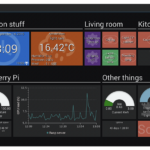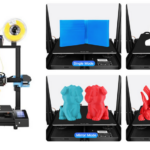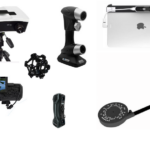Additive manufacturing or 3D printing is more affordable than it’s ever been. Although some hobbyists buy a printer for crafts and to experiment with, it’s also an excellent engineering tool for innovative electronics or robotic projects.
Typically, printers offer complimentary 3D models or free downloads that are ideal to start with. Eventually, you’ll likely want to design more customized parts. There are several 3D modeling software programs that offer a range of versatility and options. Some programs are free, and others will cost you. Some are easy to use, and others require a learning curve that takes time to master.
Below are a few of the options available to suit different user needs and preferences.
Free 3D modeling software
Open-source tools or software with free trials are ideal for first-time users. They provide a platform to learn, practice and identify your end goals for 3D design and development.
Here are a few complimentary software programs…

SketchUp
Better known for architectural designing, SketchUp is equally relevant for 3D printing and is one of the easiest 3D modeling software available — making it ideal for beginners. It runs on a web browser, Chromebook, or iPad, and with a plugin, users can easily create STL files for print. Its basic platform is free and perfect for rapid prototyping. A subscription service is available for professional or commercial use (starting at $119/year).
SketchUp’s advantage is its simplicity and abundance of tools, including more than 4M+ pre-built 3D models (although these are not specific to electronics). You can build your first custom 3D model in a few hours or have a detailed model ready within a day. However, you’ll have to upgrade to SketchUp Pro ($299/year) for proper 3D printing and extended functionalities.

Blender
Blender is a relatively advanced open-source 3D modeling software free of cost. It’s commonly used for sculpting, architectural designs, VFX, video editing, video games, and 3D printing. Unlike SketchUp, Blender requires patience and effort as the software is sophisticated. Most find the results are worth the effort, and it does offer community support. There are several free online tutorials for learning Blender, plus the open-source community is proactive in sharing their 3D designs and STL files.

Rhino
Rhino is one of the best 3D modeling software programs for curved surface designs. Most modeling tools only handle basic geometrical shapes, but Rhino is a master with NURBS, curved designs, and can adapt LiDAR scans. It’s free for a 90-day trial, and the commercial version costs $995 (with a permanent license), and works on Mac OS X and Microsoft Windows.
Rhino includes a plugin solution, a developer platform, and a scripting language to fine-tune 3D designs. For non-developers, it comes with a Grasshopper tool that offers parametric modeling without any code. The tool is widely used for industrial, automotive, architectural, graphic, and CAD/CAM designs.

DAZ 3D
DAZ 3D is a fun-to-use free 3D modeling software for artists. Designed for animation movies and video game development, it’s useful for designing lifelike characters, face morphing, animation, and custom designs. There are additional paid 3D assets available, including custom shapes, people, and animals.
The 3D models or characters designed in DAZ 3D easily import into Blender using the DAZ-to-Blender bridge, which can then be printed in a few simple steps.
There are several online tutorials for learning DAZ Studio, which should enable character-building within a day. If you enjoy designing electronic toys or lifelike robots, DAZ studio is for you. You can even upload photographs and create a character based on one.

FreeCAD
An open-source parametric 3D modeling software, FreeCAD is excellent for designing real-life objects, including mechanical designs. You can start with a 2D sketch and turn it into a 3D model. These 3D models can be exported in STL, OBJ, DXF, STEP, SVG, IFC, IGES, and DAE file formats, of which STL, DXF, and OBJ can be printed. It uses Python for scripting the 3D models.
FreeCAD is an advanced program that’s evolved over two decades for mechanical engineers. It can be downloaded for Mac OS X, Microsoft Windows, and Linux. It offers several tools including a robot simulation module, CAM/CNC workbench, finite element analysis tools, dedicated BIM, and experimental CFD. There’s a FreeCAD online manual and Wiki can be referenced for learning.

TinkerCAD
TinkerCAD is a free online tool for circuit designing and simulation. The models are created by combining geometrical shapes. A browser-based 3D software, TinkerCAD is ideal for kids to learn how to print. It can export 3D models into STL files, which can be printed into real-life objects by any 3D printer.
Aside from 3D modeling, TinkerCAD’s tools can be used to prototype digital electronic circuits, including for use with Arduino, ATiny, and Micro:Bit. It has a simulator for microcontroller boards and can run-test embedded codes before physical interfacing. It can also be used to inspect how components respond virtually using an interactive code editor to simulate virtual projects.
For 3D printing, TinkerCAD is a basic tool, so an advanced program is required for product or engineer designs.

OpenSCAD
OpenSCAD is a developer-friendly 3D modeling software free of cost. It downloads for Mac OS X, Microsoft Windows, and Linux. A unique modeling tool, OpenSCAD heavily relies on scripting and coding for creating models. Although it’s possible to create 3D models with a mouse, the software is best used for its scripting capabilities — making it potentially intimidating for non-programmers.
It’s recommended that beginners familiarize themselves with Blender or FreeCAD before switching to OpenSCAD. It uses a functional programming language with C++ syntax.

3D Slash
3D Slash is interactive, easy to use, and ideal for beginners, offering a free trial version for browser or desktop applications. The premium platform is only $2 per month. 3D Slash also offers several advanced features for creating detailed designs, best used via the desktop app. This software can export models in STL, OBJ, DAE, and FBX formats; all are 3D-print ready.

Fusion 360
Fusion 360 is a professional 3D modeling software that combines design, engineering, electronics, and manufacturing capabilities. It’s the first and only 3D modeling tool with integrated Cloud-based CAD, CAM, CAE, and PCB software. The free trial of the software can be downloaded online, with commercial use available for a licensing fee of $500/year.
This software has been designed for professional use, however, beginners can get through it with some training. Fusion 360 exports 3D models into DXF, FBX, OBJ, STL, STEP, 3DM, and other file formats that are 3D-print ready. It has several built-in features that can be used to evaluate the physical properties of a model even before it’s printed.

Cinema 4D
Cinema 4D is a professional 3D modeling software with a 14-day free trail. The commercial version costs $60 per month. It’s used for 3D modeling, VFX, game development, virtual reality, augmented reality, mixed reality, architecture, and motion graphics. It also allows for capturing 3D models from a series of photographs.
Cinema 4D offers several tools for interactive modeling, re-topology, and advanced spline modeling. It includes parametric, polygonal, and volume modeling, as well as sculpting, fusion compositions, and several other useful features. It exports models into OBJ, STL, VRML, COLLADA, and any LWO formats that can be 3D printed.

Meshmixer
Meshmixer is an older version and a free alternative to Fusion 360 for beginners. The software has not been retired but is no longer in development. Many of the features in Fusion 360 are inherited from Meshmixer, which is available for Microsoft Windows.
This software works with triangular meshes and is useful for repairing 3D scans and models before printing. Hollowing is one of its commonly used tools that allow for printing lighter models. Additional tools include branching support structures and automatic print bed orientation, layout, and packing. Meshmixer is used for mesh mixing, 3D sculpting, re-meshing, mesh smoothing, surface stamping, stability, and thickness analysis.

Wings 3D
Wings 3D is a free, open-source 3D modeling software written in Erlang, a functional programming language. It has a simple interface with context-sensitive menus and several tools for meshing and selection. It also supports lights and materials and has a built-in UV-mapping facility.
Winds 3D is easy to learn and can be used for 3D modeling, printing, and engineering design, but not animation. The software is available for personal and commercial use and is actively maintained by a community. It downloads for Mac OS X, Microsoft Windows, Linux, and Unix systems. On Mac OS X, it requires Mohave, and for Windows and Linux, it requires OpenGL 2.1.

Vectary
Vectary is a browser-based 3D modeling software that’s available for free or as a premium version ($12/month). It acclaims to be the most accessible platform for 3D modeling and augmented reality. It requires no coding and includes a vast 3D assets library. There are zero limits for file size.
Up to 25 projects can be created and exported to OBJ and STL file formats for 3D printing with the free version, including access to the 3D assets library. The licensed version is ideal for collaborative projects and offers project sharing, access and digital asset management, and versioning features.
Vectary allows 3D scaling, various colors and materials, simulating lighting effects, descriptions and labels, and real-time sharing for collaborative projects. It’s a worthy software for beginners and experts who want to build, simulate, and realize 3D models in augmented reality before physically printing them.

Houdini Apprentice
Houdini Apprentice is a free version of Houdini FX for non-commercial use. Houdini FX is a powerful animation tool for VFX, video game development, and video editing used by popular Hollywood studios like Walt Disney, Dreamworks, Pixar, and Sony Pictures. The movies like Frozen were animated using Houdini FX.
The free Houdini Apprentice is an excellent tool for beginners to try 3D modeling and animation. Its nodal workflow interacts with engineering designs in a manner that’s not possible with conventional 3D modeling tools. The software has several out-of-the-box features that simplify problem-solving and design engineering.
Houdini Apprentice is worth trying to experience its nodal workflow and model testing, but after experience on Blender, Solidworks, or other typical 3D programs. Plus, Houdini allows you to use VFX animation typically used in movies.

SelfCAD
A beginner-friendly 3D modeling software, SelfCAD can be used for sketching, sculpting, 3D modeling, design, rendering, STL slicing, and animation. The software is tuned for 3D printing and lets users slice STL and G-code files online. SelfCAD aims to make 3D designing and printing accessible to everyone. No prior experience in CAD/CAM is required to use the software.
There’s a free and commercial version ($14/month or $599 for a permanent license), available as desktop (PC and Mac) and browser-based applications. A hybrid version also allows syncing online and offline projects anytime and anywhere. There are also discount available for students and educators.
The tool has a short learning curve, with several tutorials available online. This is one of the affordable software that combines 3D modeling and printing in a seamless workflow.

Rocket 3F
Rocket 3F is a Microsoft Windows-based 3D tool for polygonal modeling. It’s useful for modeling, re-topology, sculpting, push-pull, hard edging, and non-linear sub-division edge creasing. Rocket has a free and pro version ($99). The premium version has a fully customizable user interface and a more extensive toolkit. The software exports 3D models into OBJ, DAE, and FBX file formats.
BlocksCAD
A Cloud-based 3D modeling tool, BlocksCAD is designed for educating students in 3D designing and printing. The software is easy to learn and offers several 3D assets available free of cost. The models can be exported to print-ready STL files. A paid version for schools includes educational features like lesson planning and student management.
You may also like:
Filed Under: 3D Printing, Applications, Arduino, Tech Articles






Questions related to this article?
👉Ask and discuss on EDAboard.com and Electro-Tech-Online.com forums.
Tell Us What You Think!!
You must be logged in to post a comment.